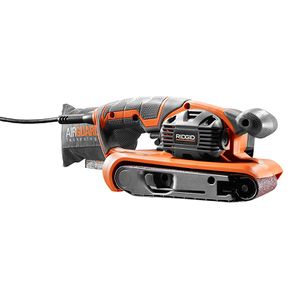Difference between revisions of "Belt Sander"
| Line 63: | Line 63: | ||
==Certification== | ==Certification== | ||
| − | [https://foxtale.georgefox.edu/moodle/course/view.php?id= | + | [https://foxtale.georgefox.edu/moodle/course/view.php?id=31328 Foxtale Course] |
==Troubleshooting== | ==Troubleshooting== | ||
Revision as of 09:05, 26 March 2020
Make: Rigid
Model: R2740
Ace: Needed (Makerhub@georgefox.edu).
Location: Wood Shop
Description
The belt sander is good for sanding large, flat work-pieces. This is a tool that can greatly reduce the amount of time it takes to finish a project, but it can be difficult to master. Depending on the speed at which it is ran and the coarseness of the sanding belt used, this tool can remove material very quickly. This tool is best used for rough passes, and is not recommended for finely detailed or delicate work.
Here is an example of this piece of equipment being used.
Documentation
Terminology
Training
Overview
In order to use the belt sander, begin by inspecting the sanding belt condition with the sander unplugged. Make sure the the sanding belt is not clogged with sawdust, remelted glue, or other gunk. A lever on the side will lock or unlock the belt in place. The knob located on the side near the roller allows the tracking of the sanding belt to be fine tuned. If the belt pulls to one side the knob should be used to finely adjust the roller angle to keep the sanding belt tracking. Material removal can happen quickly when using a belt sander with course grit so exercise caution. As a final step in the preparation to sand, ensure that the belt sander is set to run at an optimal speed for the type of wood and type of work to be done on that wood. The speed can be adjusted using the dial located near the hand grip.
Sand the work piece by working along the grain, and aim to overlap each pass with the the belt sander by about half of the previous passes width (1 1/2 in). The belt sander's own weight will keep it on the work piece and removing material- it should not take much additional pressure at all to sand the workpiece. Keep the belt sander flat. Rocking back and forth of the belt sander will result in scratches, nicks, and valleys in the surface. Exercise special care when the belt hangs off the work piece, not holding the belt sander flat will result in more material being taken off the edge of the piece than elsewhere. Despite the most careful handling, natural variations in wood can cause some of the wood to be sanded off faster than wood elsewhere. It is often advisable to draw lines of over the area that is to be sanded with a soft leaded pencil. By observing the gradual fading and disappearance of these lines, a flatter surface can be maintained.
When finished with the belt sander, make sure it has stopped spinning before setting it down. Never place it on the work piece as you may scratch or mar the material.
Demonstration
Insert text
General Procedure
Insert text
Safety
Insert text
Certification
Troubleshooting
Maintenance
General maintenance
Insert text
Specific Maintenance Tasks
| Maintenance Procedure | Frequency | Done By |
|---|---|---|
| Sample | Sample | Sample |

